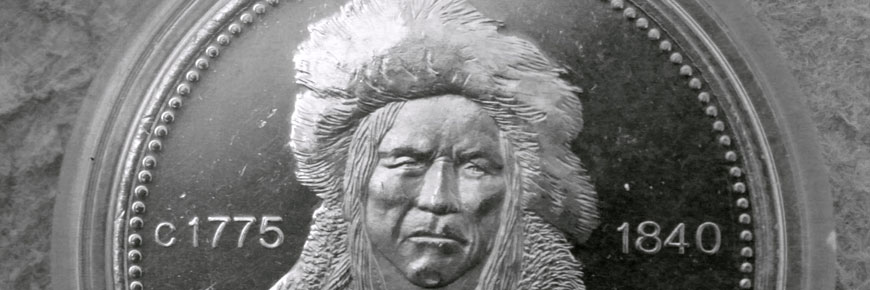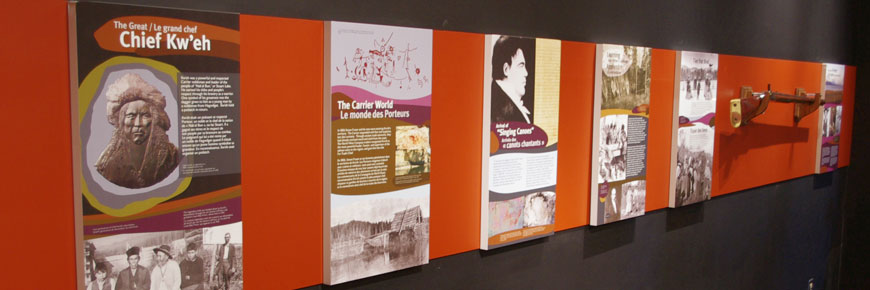
A Lasting Legacy: Chief Kw’eh
Chief Kw'eh
Fort St. James National Historic Site
A Lasting Legacy: Chief Kw’eh
 Chief Kw'eh's dagger
Chief Kw'eh's dagger © Parks Canada
Chief Kw’eh was a leader of the Dakelh people at Stuart Lake in the village of Nak’azdli. During his early life he distinguished himself as a warrior within a cycle of warfare between the Dakelh of Stuart Lake and the Tsilhqot'in (Chilcotin) people to the south. In 1806, when Simon Fraser and his party arrived in Nak’azdli (Stuart Lake) to establish fur trade posts for the Northwest Company, Chief Kw’eh took on the role as fur trade chief, negotiating the new relationship between his people and the newcomers. This role continued after 1821 when the Hudson’s Bay Company became in charge. Chief Kw’eh’s success as an intermediary and diplomat helped create peaceful relations in the region and resulted in him becoming the key Aboriginal leader of a wide territory. He is remembered as “dreamer of the salmon,” and is thought to be still providing for his people by presiding over the salmon fishery from his burial place at the mouth of the Stuart River.
Remembering Chief Kw’eh
According to oral tradition, Kw’eh had four wives from four different villages on Stuart Lake. Today, many of Chief Kw’eh’s descendents can be found residing at Nak’azdli, Tachie, Yekooche and other nearby villages. Amongst these descendents, the memory of Chief Kw’eh lives on. Twenty years ago, the Nak’azdli Elders Society worked with Parks Canada to conduct a multi-year oral history project. Local elder Lillian Sam edited some of that valuable material into a publication, Nak’azdli t’enne Yahulduk – Nak’azdli Elders Speak (2001). Lillian has been especially interested in preserving the story of her great-great grandfather, Chief Kw’eh, by collecting and researching oral stories, genealogies, and written records. Through her efforts, Chief Kw’eh’s legendary knife and several other valuable displaced artifacts were returned to the community.
The “King” of the Dakelh
By the time of his death, Chief Kw’eh was considered the most important Aboriginal person in New Caledonia, from the perspective of both the traders and the Dakelh First Nations. The traders had even dubbed him “the King.” It was one of several names Kw’eh acquired over his lifetime. Within the clan/potlatch structure, he had earned the name “Ts’oh Dai,” a very important traditional title in the Lhts'umusyoo (Beaver) clan. Over his many years (c.1755-1840) Kw'eh's ability to provide for others, his ability to mediate disputes among his clansmen, and his conciliatory approach in conflicts with Daniel Harmon and James Douglas enhanced his status as leader in the eyes of his people and the trading companies.
How can I learn more about Chief Kw’eh?
Visitors to the Fort St. James area have a number of possibilities to learn more about Chief Kw'eh. In the summer of 2012, Fort St. James National Historic Site opened a new exhibit which includes the original dagger belonging to Chief Kw’eh. The small resource corner of the exhibit features a number of excellent publications about fur trade and local history. Good reading opportunities include The Carrier-My People by Lizette Hall, The History of Northern Interior BC by Father A.G. Morice and others.

Nomination Process
Ordinary Canadians can nominate extraordinary people, places and events to be recognized as of national historical significance in Canada. The effort to nominate Chief Kw’eh as a person of National Historic Significance began with the Chief, elders and community members of Nak’azdli. At a meeting in 2006, community members enthusiastically agreed to begin the process. Nak’azdli chief Leonard Thomas followed up by writing a letter to the Historic Sites and Monuments Board of Canada (HSMBC). The letter was positively received in Ottawa, and it was time for the hard work to begin.
A detailed history of Chief Kw’eh’s life and contributions was required. But unlike many of Canada’s significant historic figures, Chief Kw’eh’s record is not lying within a library or archives. The details and interpretations of Chief Kw’eh’s life dwell largely in the realm of oral tradition. Local elder Lillian Sam was contracted as community researcher and co-author of the submission report, working with Parks Canada historian, Frieda Klippenstein.
When it was finally complete, the report was considered by the National Historic Sites and Monuments Board at a meeting in July 2009. The HSMBC’s positive recommendation was formally signed off by the Environment Minister Peter Kent this spring, and Chief Kw’eh’s designation was publically announced in March 2012.
 Left: Chief Louis Billy, a Dakelh descendent of Chief Kw'eh (photo: Hudson's Bay Company Archives). Center: Lillian Sam, local author, historian and great great grandaughter of Chief Kw'eh (Photo: Parks Canada Coll). Right: Chief Louis Billy (Photo: Lillian Sam).
Left: Chief Louis Billy, a Dakelh descendent of Chief Kw'eh (photo: Hudson's Bay Company Archives). Center: Lillian Sam, local author, historian and great great grandaughter of Chief Kw'eh (Photo: Parks Canada Coll). Right: Chief Louis Billy (Photo: Lillian Sam).
- Date modified :